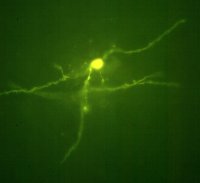
Membrane properties and function of glial cells
 |
To better understand the role of glia in physiological and pathological states, the membrane properties of astrocytes and oligodendrocytes have been studied in acute brain and spinal cord slices using the whole-cell patch-clamp technique. In the gray matter of rat spinal cord slices, astrocytes, oligodendrocytes and their respective precursors can be distinguished based on their pattern of membrane currents and immunohistochemical identification. Astrocytes, oligodendrocytes and glial precursor cells in the spinal cord gray matter are also sensitive to glycine, GABA, glutamate, kainate and NMDA. These and other studies have demonstrated the presence of neurotransmitter receptors on glial cells.
The cell membrane of astrocytes and oligodendrocytes is almost exclusively permeable for K+. Recent patch-clamp experiments in our laboratory have revealed a significantly higher concentration of extracellular K+ around oligodendrocytes than around astrocytes. These and other results demonstrate that the increased accumulation of K+ in the vicinity of the oligodendrocyte membrane results from a smaller ECS volume around oligodendrocytes than around astrocytes. Heterogeneities in the nervous tissue, represented by “clusters” of compact ECS around oligodendrocytes, can facilitate K+ spatial buffering and selectively affect the diffusion of ions and other neuroactive substances in specific areas and directions.
